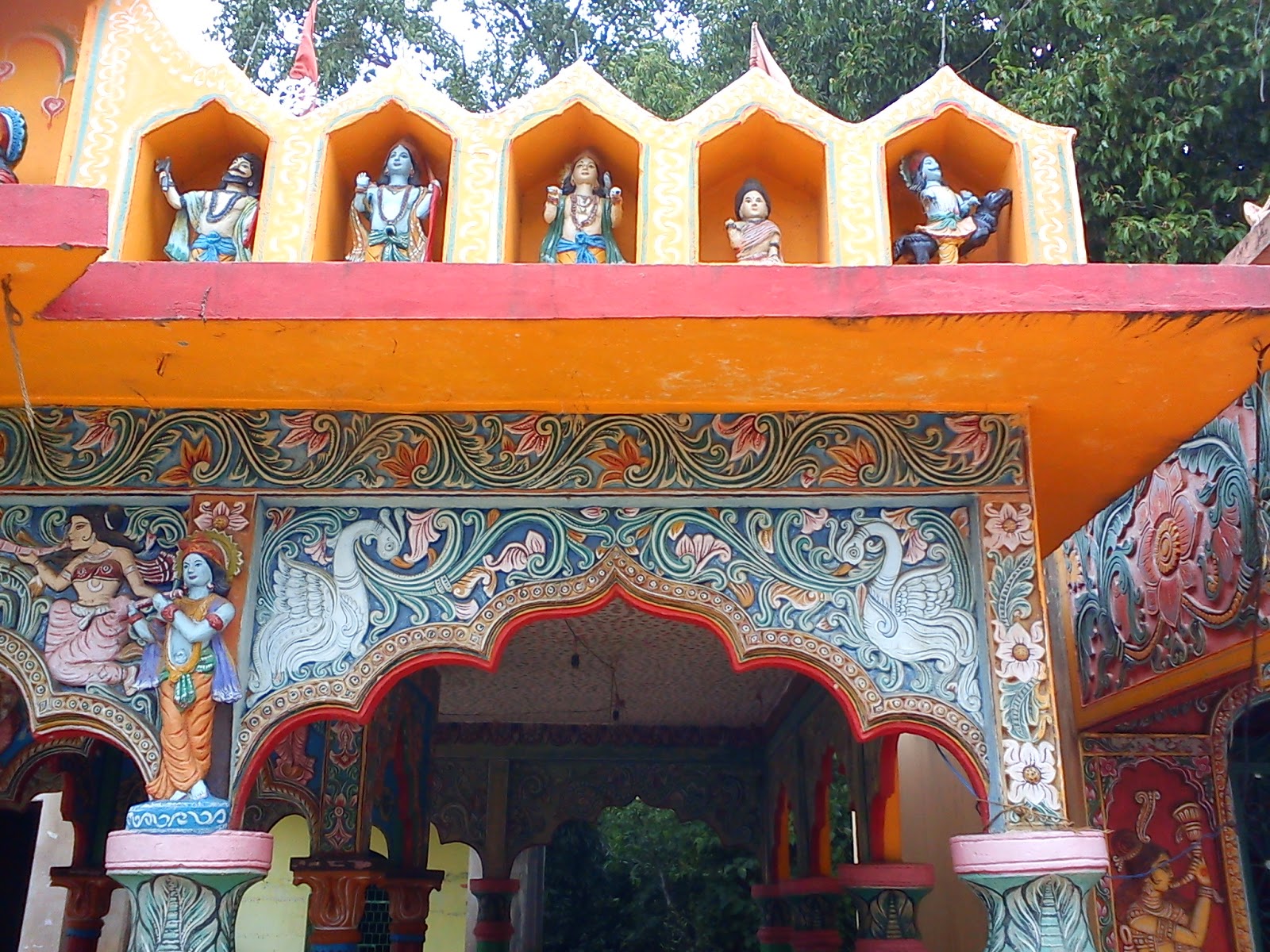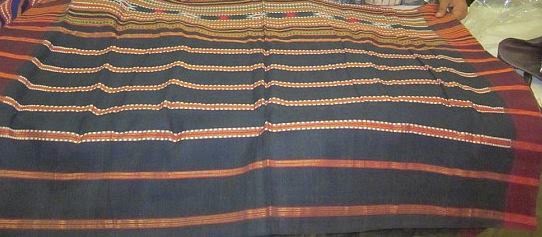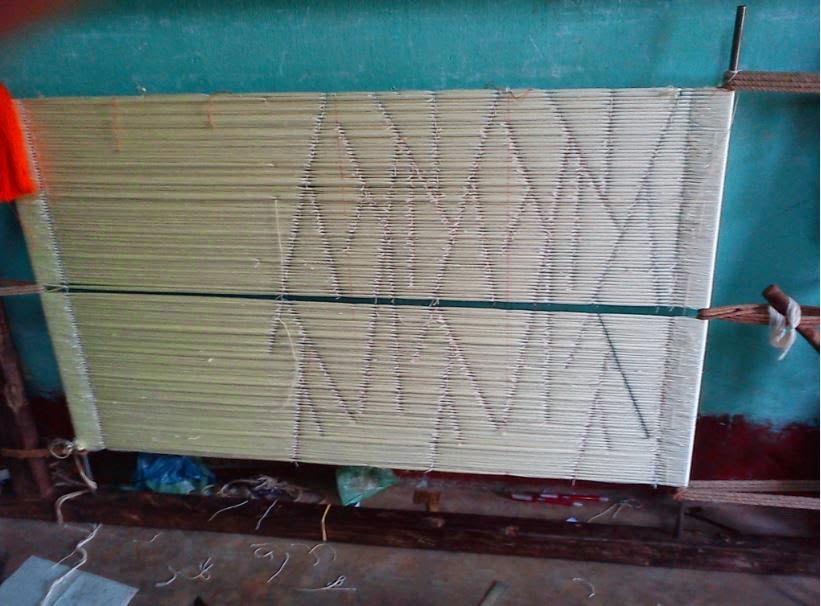Textile Notes related to fiber, yarn, fabric knowledge, spinning, weaving, processing, projects, knitting, Indian Traditional Textiles and denim manufacturing
Friday 27 June 2014
Thursday 12 June 2014
Gopalpur Ikat Weaving Cluster
The way was literally littered with the inspiration from the motifs of Pat Chitra. Here are some glimpses. The pictures are taken from a temple.
Gopalpur is known for the tussar weaving. They tie and dye the yarn to create the temple motifs. The tying and dyeing is not practiced here and they buy it from Nuaptana. They also do a lot of Ghicha weaving.
Below is a white eri sari. Notice the contamination of the yarn, because the moth escapes out of the cocoon by secreting a fluid. A fine example of Ahimsa Silk.
An example of ghicha Temple sari woven on the loom.
Notice the bow used to control the width, it also leaves a few holes in the sari at the selvedge
The temples are adjusted and aligned by pulling out the yarn at the selvedge itself, no doubt these sarees have uneven selvedge.
The picture and video below depicts weaving of weft Ikat in the Gopalpur ( Jazpur) Orissa. The saree is woven on the wrong side. See carefully how the design is adjusted by pinching the weft after each pick is inserted. The result is a beautiful design, the "flaw" at the left side of the sari are the "pinched" portion of weft to adjust the design. Incidentally, the Ikat in Gopalpur is woven in Majority of Tussar ( 33/37) with a classic temple motif done in weft ikat, which can also be seen in the video.
Wednesday 11 June 2014
Nuapatna Ikat Textile Cluster-3
This one is called the Khandua Society.
Khandua fabrics and Sarees are in general products woven in the Nuapatna Cluster.
Was impressed to see the technical innovation done in handloom to ease the life of weavers. Use of pedal, chain and wheel from cycle to adoptation of Tara loom to weave weft ikat is amazing. Have a look.
Khandua fabrics and Sarees are in general products woven in the Nuapatna Cluster.
Was impressed to see the technical innovation done in handloom to ease the life of weavers. Use of pedal, chain and wheel from cycle to adoptation of Tara loom to weave weft ikat is amazing. Have a look.
In general in all these sarees the border portion is weft tyed-died while the body portion in weft ikat.
To know more read the document in this journal
Tuesday 10 June 2014
Nuapatna Ikat Textile Cluster-2
This cluster specializes in making Dongria and Siminoi Sarees, which are woven motifs inspired from the embroidery and colors used by Dongria and Siminoi tribes of Orissa.
Dongria
Apart from the that traditional Ikat sarees were woven. EPI x PPI for Silk sarees is 88x 80 for Cotton it is 70 x 80.
The count used in Silk is Bangalore x Maldah ( 20/22 degummed x 33/37 degummed) for Cotton it is 120s x 2/100s.
Dongria
Siminoi
Apart from the that traditional Ikat sarees were woven. EPI x PPI for Silk sarees is 88x 80 for Cotton it is 70 x 80.
The count used in Silk is Bangalore x Maldah ( 20/22 degummed x 33/37 degummed) for Cotton it is 120s x 2/100s.
Monday 9 June 2014
Nuapatna Ikat Textile Cluster
Nuapatna
This place is known for its Ikat Textiles, specially Sarees. The ikat used is weft Ikat.
When we reached, it was a hot summer day with temperature soaring up to 45 deg C with humidity. But looking at the "cool" weaving, took away some of the heat.
Frame looms are used to weave.
Note the "Comb" used at the selvedge to control the border ends. Note also the absence of warp stop motion. Which means weavers eyes are the only instruments to detect a defect, and it one can only spot a missing end ( Chira) in a 2/100s count cotton only after a few picks have been woven. So expect some missing ends in the warp.
This place is known for its Ikat Textiles, specially Sarees. The ikat used is weft Ikat.
When we reached, it was a hot summer day with temperature soaring up to 45 deg C with humidity. But looking at the "cool" weaving, took away some of the heat.
Frame looms are used to weave.
Look at the "bow" used to control the weft, this gives wavy selvedge to the saree. Considered by some as a defect,this is inherent to the manufacture of this saree.
Frame used to tie and dye the weft yarn. The pattern is prepared on the frame then it is transferred to weft spools and then these are used in the loom for weaving.
The count used is 2/100s or 2/120s for cotton. Both mercerised and non mercerised cotton is used. Silk used is Bangalore (20/22 denier degummed) or Maldah Silk (30/33) denier Mulberry. In Nuapatna Generally Bangalore Silk is used in the warp and Maldah is used in the weft.
Note the "Comb" used at the selvedge to control the border ends. Note also the absence of warp stop motion. Which means weavers eyes are the only instruments to detect a defect, and it one can only spot a missing end ( Chira) in a 2/100s count cotton only after a few picks have been woven. So expect some missing ends in the warp.
Throughout India, home made dobby attachements are used to create the design. Here is the Nuapatna version.
Notice the lingos falling down at the border.
To create this design below the following steps are done:
1. White fabric is ties for the first time
2. Then it is dyed in the motif colorr. ( Fawn)
3. Then the motif only is tied.
4. Then it is treated with hydro ( Sod. Hydrosulphide) to take away the color from the remaining portion- if needed.
5 Then the background is dyed.
Generally acid dyes are used for silk and vat dyes for cotton. However, the characteristic "red" of Ikat will bleed as it is dyed in napthol color. For all the bright colors napthol dyes are used, which may bleed. They have also started using the reactive dyes, but is it very rare.
Do you see the little zig-zag line at the left side in the picture above , this is how the weavers control design, they make sure that this zig-zag line is maintained by pinching a small amount of weft. which is shown as a loop in the wrong side of fabric. So mind you, if you get those loops of yarn at the side of the fabric, these are not defects but effects inherent to the weaving technique.
This is Nuapatna No. 1, there are many more such societies. Surprisingly each have a different language of products.
This society has an elaborate stand for checking the sarees against the light.
Sunday 8 June 2014
Fulia Weaving Cluster-2
The Next stop was Nutan Fulia, a government cooperative society. Despite being government, the range and variety of products and the efficiency in their operations, makes it unique it its own way.
For an artisan cluster, they have a water treatment plant also.
For saris they work with Tussar, Matka, Ghicha, Cotton and Silk. The usual denier for silk is degummed 20/22 and 100s count for cotton. Also use viscose rayon for ornamentation.
Have a look at the beautiful pallu of this Sari above. The pallu is done in Shibori Technique ( the fabric is stitched in patterns then dyed and then the stitches open. Notice how the variability in terms of streaks come ( the black lines) which is a part of this unique process.
This society boasts of modern dye house with reactive and vat dyes. They have chambers but are not operational yet.
For an artisan cluster, they have a water treatment plant also.
For saris they work with Tussar, Matka, Ghicha, Cotton and Silk. The usual denier for silk is degummed 20/22 and 100s count for cotton. Also use viscose rayon for ornamentation.
Below is the details of the zari used by them. It says per bundle 225 grams containing three reels.
We had rains in the morning. The evening while coming back looked beautiful. These are pictures clicked from a Restaurant on our way to Kolkata.
Subscribe to:
Posts (Atom)

















































